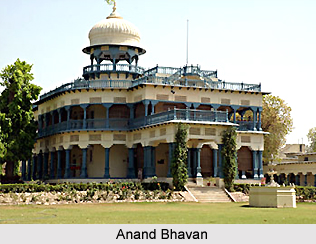 Tourism of Allahabad includes some historically important places such as Allahabad Fort, the Triveni Sangam, Anand Bhavan, Swaraj Bhavan, Khusro Bagh and at the same time various other parks and shrines. The city of Allahabad is historically important as it is situated at the confluence of the rivers Ganga, Yamuna and Saraswati. Owing to this strategic location it always has been the centre of attraction for the Muslim and the British rulers.
Tourism of Allahabad includes some historically important places such as Allahabad Fort, the Triveni Sangam, Anand Bhavan, Swaraj Bhavan, Khusro Bagh and at the same time various other parks and shrines. The city of Allahabad is historically important as it is situated at the confluence of the rivers Ganga, Yamuna and Saraswati. Owing to this strategic location it always has been the centre of attraction for the Muslim and the British rulers.
Triveni Sangam
Triveni Sangam is the confluence or meeting point of three rivers. They are Ganga, Yamuna And the mythical Saraswati river. This place has a great religious value among Hinduism. This place is around 7 Km from the civil line. It is the place where the brown coloured Ganges meets the greenish Yamuna with invisible Saraswati. Triveni Sangam has enormous religious value as it is believed to be the exact place where drops of nectar fell. So it is considered that having a bath in the holy confluence will wash out all the sins and impurities. As per the mythical documents Lord Brahma performed the Prakrista Yajna here. On the banks of the confluence the sacred Kumbha Mela is held every 12 years.
Allahabad Fort
Allahabad was a part of the Delhi Sultanate and understanding its strategically important location Mughal Emperor Akbar built a magnificent fort on the banks of the holy confluence. This fort contains an immense value as Jahangir; son of Akbar became the successor of it later. The fort shows great and complicated craftsmanship in architecture.

Anand Bhavan
Anand Bhavan is a huge manor that was owned by Motilal Nehru in the 19th century. It remained the ancestral home of the Nehru-Gandhi Family of India. Today it has been transformed into a museum and is run by the `Jawaharlal Nehru Memorial Fund`. It is the place where Mahatma Gandhi used to spend his days during his visits. In the Anand Bhavan complex Jawahar Planetarium is also located.
Swaraj Bhavan
Swaraj Bhavan is also another historical building built by Motilal Nehru which he donated in the year 1930 for the purpose of India as it was used to be the headquarters of the Congress Committee. Indira Gandhi, former Prime Minister of India, was born here.
Khusro Bagh
Khusro Bagh is another important place where Khusro, son of Jahangir, and Shah Begum were buried. It is a large garden which comprises the tombs of the two.
Mayo Memorial Hall
It is positioned near the Thornhill and Myne Memorial in Allahabad. This large hall includes a 180-feet high tower. London`s South Kensington Museum`s Professor Gamble designed the interior of this hall.
All Saints Cathedral
This Cathedral was built in Gothic Style in 19th Century. It is popularly known as Patthar Girja Ghar and situated at a prominent location of the city in lush green premises. It is one of the finest Cathedrals of India. Though it was sanctified in 1887, it needed another 40 years for it to be complete.
Hanuman Mandir
Hanuman Mandir is an important Hindu shrine of Allahabad. This temple is famous for the unique supine image of Lord Hanuman. It is the only temple where Lord Hanuman is in a reclining pose.
Allahabad Universi
Allahabad University is the fourth oldest university of India. It is popularly called as the Oxford of the East. This University comprises of many heritage buildings.
Apart from all these, there are other places of interest also in Allahabad such as Alfred Park, Minto Park, Upardaha Lake, Kaushambi and Kara.



















